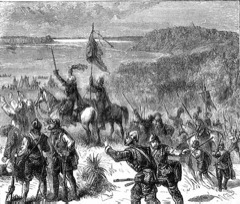Diego de Moraga, was born in 1591 in Mexico City. In 1632, he married Juana Bernal y Griego and they eventually made their way to Santa Fe, New Mexico.
The children of Diego and Juana de Moraga are reported to include Juan Alonzo Moraga, born circa 1633, place unknown, died in Santa Fe, New Mexico or El Paso. Other children of Diego de Moraga included son Capitan Alonso de Moraga, born circa 1641; son Lázaro de Moraga, daughter Ana de Moraga.
Juan Alonzo Moraga, who married María Montaño, was a mestizo blacksmith, according to one source, who said he set out in the early autumn of 1660 with Santa Fe Alcalde Diego Romero to visit the Eastern Plains to barter with the Indians.
Juan Alonzo Moraga’s children included daughter Antonia de Moraga, born circa 1649 or 1660, died 5 Aug. 1729 in Chimayo; son Felipe, born 1664.
Juan Alonzo Moraga died in 1680, the year of the Pueblo Indian Revolt, possibly in El Paso after he was first forced to flee to Santa Fe.
As many 400 Spanards were killed and up to 3,000 were believed to have been driven out of the area that year, returning to Guadalupe del Paso (El Paso), not able to return until after Santa Fe was retaken in 1692, including Antonia de Moraga and Felipe
Lázaro de Moraga eventually married Agustina de los Reis (Reyes). Children included daughter Estephana, said to be a mestisa baptized 7 Jan. 1685 in El Paso), and Joseph Antonio Moraga, born either 1692 or baptized 1 April 1687. Other children included Maria Moraga, Francisca Moraga, Antonia Moraga and Juana Moraga.
While there is no documented evidence linking the El Paso Moragas with the northern Sonora Moragas, a Sonoran recruitment party arrived in El Paso in the 1693 and recruited 25 soldiers and their families to serve at the Presidio in Fronteras.
Lázaro de Moraga went to Sonora, along with his nephew, Felipe, and served in the campaign against the Pima in 1685, along with a Juan de Moraga, b. 1660.
Felipe returned to the Chamayo region of New Mexico, obtained his father’s property, and married Catarina Valeria.
Lazaro de Moraga returned to the El Paso region and was residing 1710 in Senecú de Sur, Chihuahua, a small Mexican village on the outskirts of Cuidad Juárez, across the U.S. border from El Paso.
To this day the Moraga name can be found in Texas, New Mexico and elsewhere in the southwest.

